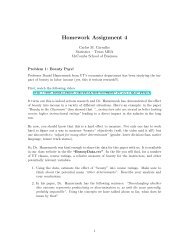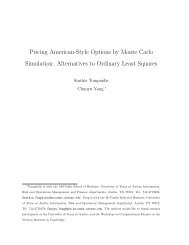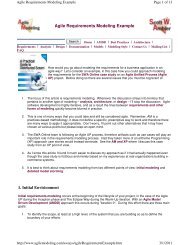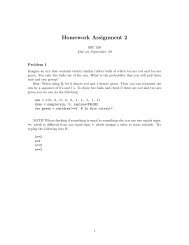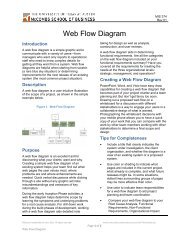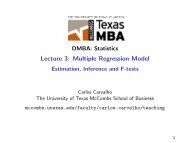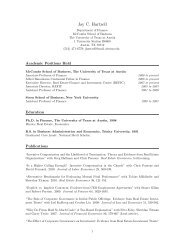Homework Assignment 2 - McCombs School of Business
Homework Assignment 2 - McCombs School of Business
Homework Assignment 2 - McCombs School of Business
You also want an ePaper? Increase the reach of your titles
YUMPU automatically turns print PDFs into web optimized ePapers that Google loves.
Problem 6<br />
Read the “Milk and Money” case in the course notebook. The data file is available in the<br />
class website.<br />
Important information:<br />
1. The Federal government, through the Agricultural Marketing Service (AMS), sets the<br />
price that dairy farmers receive for different “classes” <strong>of</strong> milk (these classes are called<br />
Class I, Class II, etc.). The prices set by the AMS depend on, among other things,<br />
the wholesale price <strong>of</strong> milk and can vary significantly over a two or three year period.<br />
In this problem, we will be concerned only with Class III milk prices.<br />
2. A farmer can purchase a put option that gives him the right but not the obligation to<br />
sell a futures contract on Class III milk at the “strike” price on or before the expiration<br />
date <strong>of</strong> the option. This puts a “floor” under the price that the farmer will receive for<br />
his Class III milk. He removes the downside risk but still has the upside potential.<br />
For example, suppose the strike price on a December 15 Class III milk put option is<br />
$12/cwt (cwt is a unit <strong>of</strong> measurement that is roughly 100 pounds <strong>of</strong> milk). If the<br />
AMS price on December 15 is below $12/cwt, the put option allows the farmer to sell<br />
his milk for $12/cwt. If the AMS price is greater than $12/cwt then he will sell his<br />
milk at the AMS price.<br />
The cost <strong>of</strong> the put option is the price a farmer must pay someone to take on the<br />
downside risk. For example, the cost <strong>of</strong> a $12/cwt December 15 put option purchased<br />
in June might be $0.45/cwt.<br />
The farmer must also pay trading costs for purchasing the option (e.g. brokers commission,<br />
etc.). For example, the trading cost on a $12/cwt December 15 option might<br />
be $0.05/cwt.<br />
Strike prices on put options for Class III milk are available every $0.25. For example,<br />
$11.50/cwt, $11.75/cwt, $12/cwt, $12.25/cwt, etc.<br />
3. For historical and legal reasons, California dairy farmers participate in a California<br />
pricing system rather than the federal AMS pricing system. The price a California<br />
dairy farmer receives for his milk, called the “mailbox” price, is determined by a<br />
complex formula that depends on the value <strong>of</strong> various dairy products on the wholesale<br />
market. The California mailbox price varies a great deal over time just as the federal<br />
AMS price does. For example, between 2005 and 2007 the mailbox price varied<br />
between $10.16/cwt and $19.98/cwt with an average price in 2006 <strong>of</strong> $11.28/cwt.<br />
The dairy farmer in the case, Gerard, estimates his costs are $12/cwt so a price <strong>of</strong><br />
$11.28/cwt creates a significant financial problem for him.<br />
4. Gerard is interested in hedging his revenue six months in advance and guaranteeing<br />
a price <strong>of</strong> at least $12/cwt for his milk. For example, in June he wants to hedge his<br />
December 15 revenue.<br />
5. Put options on the California mailbox price are not available. The federal Class III<br />
milk price is closely related, although not the same as, the California mailbox price<br />
7



